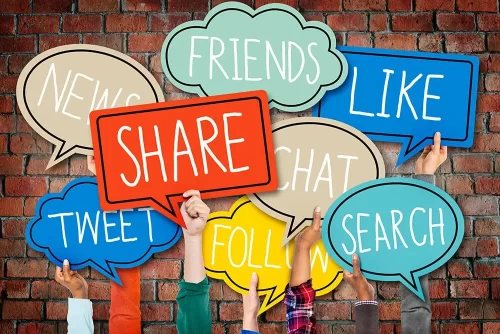Crafting compelling content is essential in the world of B2B marketing. If you want to drive engagement and generate more leads, you need content that resonates with other businesses. Keep reading to explore the most common types of B2B writing and expert tips for elevating your content writing strategy.
AI + Human Edited Content Creation.
Only $0.01 per word!

What Is B2B Content Writing?
Business-to-business (B2B) writing focuses on content tailored for businesses instead of individual consumers. It targets the needs, challenges, and interests of business clients.
The vast majority of B2B companies rely on content marketing. In fact, 91% of B2B companies use content to promote their products and services.
B2B content frequently involves industry-specific knowledge and jargon. It also comes in many forms, including whitepapers, case studies, blog articles, and newsletters.
As with business-to-consumer (B2C) writing, B2B content is often used to boost online visibility and generate more leads. However, the writing tends to be a little more formal.
The goal is to attract the interest of business owners and decision-makers. Your target audience is looking for business solutions, which is where B2B writing comes in. Producing the right type of content can help communicate the value of your B2B product or service.
Types of B2B Content
B2B content is typically used to generate interest or nurture leads. Some of the most common types of B2B content used for these purposes include:
- Blogs
- Case studies
- Use cases
- Guides and tutorials
- Whitepapers
- Press releases
- Emails
- Landing pages
Here is a quick look at each of these content types and their use for B2B writing.
Blogs
Blogs are a common part of a B2B content marketing strategy. Publishing blog articles helps transform your site into a repository of knowledge on topics related to your products or services.
B2B blogs may offer industry insights, tips, and updates geared toward your specific audience. They can help establish thought leadership, drive more organic traffic, and nurture leads by building trust.
Case Studies
Case studies are your chance to show the real-world applications and advantages of your products or services. You can highlight how past clients have benefited from your offerings.
Case studies provide detailed narratives. They outline a challenge, present your solution, and discuss the positive results. This helps show your company’s value and effectiveness. It builds credibility as it offers prospective clients tangible proof of your company’s ability.
Use Cases
Use cases focus on describing how your products or services can help in specific scenarios. This allows you to highlight selling points, such as ease of use.
Creating use cases can help potential customers how your solution addresses their unique needs and challenges. You can outline the functionality and outcomes of your product or service, which is particularly useful for complex offerings.
Guides and Tutorials
Guides and tutorials offer step-by-step instructions on how to use your product or service. A guide can provide in-depth knowledge and practical advice for getting more out of your offering. These resources help educate customers so that they can understand the value of their purchase.
Well-crafted guides can also boost customer satisfaction and loyalty. A guide can help users achieve their goals more efficiently, which improves their outcomes and overall satisfaction.
Whitepapers
Whitepapers are detailed reports that typically provide in-depth analysis, insights, and solutions related to specific industry issues. They help position your company as a thought leader and are often used to help educate and influence decision-makers.
Whitepapers are typically data-driven. They contain a wealth of data and research, making them valuable resources for B2B customers.
Press Releases
Press releases are used to communicate important news about your company. You may use a press release to announce a product launch, a new partnership, or an achievement. These releases are typically distributed to media outlets and websites to gain coverage and boost brand visibility.
Press releases need to be concise and newsworthy. They provide journalists with essential details for crafting other articles, giving you the chance to help shape public perception.
Emails
Emails are a direct communication tool and one of the most popular methods for retaining customers. About 80% of B2B marketers rely on email for customer retention.
You can use emails to directly engage with B2B prospects and customers. Emails may include newsletters, promotional offers, product updates, or personalized messages.
When you draft emails, keep them short and to the point. Provide a clear message with a direct call to action. Effective email campaigns can help boost engagement and retention, making them a useful tool for your B2B writing strategy.
Landing Pages
Landing pages are stand-alone web pages made to convert visitors into leads or new customers. They are mostly used in marketing campaigns to promote specific products or services.
A well-designed landing page includes a compelling headline, persuasive content, and a clear call to action. The goal is typically to capture contact information and move potential customers through the buying process.
B2B Writing Tips and Techniques
Use the following tips and techniques to get more out of your B2B writing:
- Focus on value. Make sure that your content provides real value to your target audience. Do not just highlight the benefits of your product or service without offering actionable insights and practical advice.
- Be clear and concise. Avoid lengthy descriptions. Use bullet points and subheadings to make your content scannable and easier to digest.
- Use data and evidence. B2B buyers are more likely to be persuaded by concrete evidence. Back up your points with data and real-world examples. Include charts, stats, quotes, and links from authoritative sources.
- Optimize for SEO. Use relevant keywords naturally throughout the text, meta descriptions, alt tags, and internal links. SEO-friendly content can help boost organic traffic and your overall online presence.
- Incorporate a strong CTA. A strong, clear call to action (CTA) helps ensure that readers know the next steps. This may include a CTA for downloading a whitepaper, joining an email list, scheduling a demo, or contacting sales.
- Edit and proofread. Always edit and proofread your content to catch errors and typos, as even small mistakes can undermine your credibility.
Last Thoughts on B2B Writing
Good B2B writing can help you generate more interest, awareness, and leads. Blog posts, whitepapers, tutorials, and case studies give you the chance to demonstrate your expertise and why B2B buyers should choose your product or service.
Keep the tips discussed in mind as you generate your content and continue to track your success. Use analytics tools such as Google Analytics to track website traffic, bounce rates, and conversions. These metrics can help determine whether your efforts are working or need tweaking.
100% human-written content by native English writers
OUR BLOG



